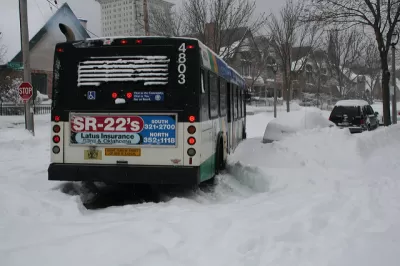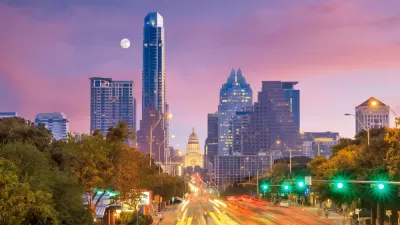Does light rail increase or decrease transit ridership? This article compares "bus only" metro areas to those which have recently built light rail lines.

As many commentators have noted, bus ridership has decreased in a wide variety of cities in recent years. Some suggest that new light rail has contributed to this decline by cannibalizing local bus service.
One way to resolve this dispute is to compare the largest bus only regions to those which have recently adopted rail. I decided to take a small step in this direction by comparing the largest "bus only" transit systems to the transit systems with the newest light rail service (in particular, those without light rail in 1996).* My "bus city" sample was comprised of cities with over 7 million bus boardings for the first half of 2017 and no significant** municipal rail service: Tucson, Albany (NY), Rochester, Detroit, Cincinnati, Columbus (OH), Las Vegas, San Antonio, and Milwaukee. If these cities had benefited from the absence of rail service, I would have expected bus ridership to stay stable between 2014 and 2017, or decrease less than the national average. Between the first half of 2014 and the first half of 2017, national bus ridership decreased from 2.61 billion to 2.38 billion, or about 9 percent. (Ridership data is available at the American Public Transit Association ridership data site.)
My results were quite mixed. Ridership was stable in Albany and Columbus during this period (as well as Detroit, where ridership declined by less than 5 percent). But in the other cities, ridership declined quite a bit. In Cincinnati, San Antonio, Tuscon, and Rochester, ridership decreased by between 10 and 20 percent between the first half of 2014 and the first half of 2017. In Milwaukee, ridership decreased from 20.2 billion to 15.9 billion trips, a decline of over 20 percent.
So how did the newest light rail cities compare? I found only half a dozen light rail regions with no light rail at all in 1996: Salt Lake City, Charlotte, Phoenix, Minneapolis, Houston and Norfolk. The results for bus ridership, standing alone, were comparable to those in the major "bus only" regions. In two (Salt Lake City and Houston), bus ridership was stable or went up slightly between 2014 and 2017. In the rest, ridership decreased by about 10-20 percent.
What about overall transit ridership—that is, bus and rail combined? By this measure, 2014-17 ridership increased modestly (by under 10 percent) in Minneapolis as well as Salt Lake City and Houston. In Phoenix and Charlotte, ridership decreased by about 5-10 percent (from 26.7 million to 25.3 million in Phoenix, 12 million to 11 million in Charlotte) and decreased by over 10 percent only in Norfolk(from 7.9 million to 6.6 million).
On balance, it seems to me that the "best" bus-only cities did almost as well as the "best" new rail cities—ridership in the "best" bus only city increased by about 1 percent, while total transit ridership in the "best" bus/rail city, Houston, increased by about 7 percent (from 40 million to 43 million trips). However, transit ridership decreased by over 10 percent in only one rail city, Norfolk, while decreasing by over 10 percent in five out of eight bus-only cities.
I also tried to take a more long run view, comparing 2017 results to those for the first half of 2007. Among the bus-only regions, ridership actually rose significantly in Columbus (from 7.3 million to 9.0) and Albany (from 6.3 million to 8.1). Ridership was fairly stable in Las Vegas (which had no 2014 statistics) and Rochester, declined by about 10 percent in San Antonio (from 19.9 billion to 18.1 million) and Tuscon (from 8.7 million to 7.8 million) and declined by over 30 percent in Milwaukee (from 25.3 million to 15.9 million) and Detroit (from 19.5 million to 11.4 million). In sum, a few bus-only transit systems did very well, but the majority were either stable or lost riders.
What about transit systems with newly adopted light rail service? Similarly, total 2007-17 transit ridership rose in some and declined in others. In Charlotte, overall transit ridership (bus and light rail combined) rose from 8.8 million in the first half of 2007 to 10.8 million a decade later, an increase of slightly over 20 percent. In Phoenix, ridership rose from 21.9 million to 25.3 million. In Minneapolis, ridership rose from 36.6 million to 40.4 million. But ridership declined in Houston and Norfolk, in both cases by about 10 percent (7.5 million to 6.6 million in Norfolk and 48.4 to 43 million in Houston).
So the best bus-only systems did very well over the long run, but it seems that the average bus-plus-rail transit system did a little better than the average bus-only system, and that some bus-only systems suffered horrendous ridership losses. What can we get from this?
First, it doesn't seem that adding light rail harmed overall transit ridership; transit ridership seems to have increased more frequently in regions with new, small light rail systems than in regions that rely solely on buses. But the small size of many new light rail systems, combined with the small number of cities involved, makes it difficult to make precise conclusions.
Second, it seems that bus-only transit systems are more volatile; they seem to have greater ridership increases and greater ridership losses than "bus plus rail" transit systems. If the political climate is hostile to transit, a bus-only system can deteriorate far more rapidly than a rail system, perhaps because cutting back bus routes is technically and politically easier than destroying a train system.
So it seems to me that on balance transit riders are better served when rail is added to the menu. However, when these additions are worth the cost is a topic I leave to other commentators.
*I note that a more detailed study might also look at systems like Denver and Dallas, which had a small amount of light rail service in 1996 and have expanded their rail massively in recent years. I also note that I have ignored commuter rail; commuter rail tends to serve longer-distance commuters and is thus not as comparable to local bus service as light rail.
**By "significant" I mean serving a wide variety of neighborhoods—thus, not including downtown-only systems like Detroit's People Mover, or the Las Vegas train that serves a portion of the Las Vegas "Strip."

Maui's Vacation Rental Debate Turns Ugly
Verbal attacks, misinformation campaigns and fistfights plague a high-stakes debate to convert thousands of vacation rentals into long-term housing.

Planetizen Federal Action Tracker
A weekly monitor of how Trump’s orders and actions are impacting planners and planning in America.

Chicago’s Ghost Rails
Just beneath the surface of the modern city lie the remnants of its expansive early 20th-century streetcar system.

Bend, Oregon Zoning Reforms Prioritize Small-Scale Housing
The city altered its zoning code to allow multi-family housing and eliminated parking mandates citywide.

Amtrak Cutting Jobs, Funding to High-Speed Rail
The agency plans to cut 10 percent of its workforce and has confirmed it will not fund new high-speed rail projects.

LA Denies Basic Services to Unhoused Residents
The city has repeatedly failed to respond to requests for trash pickup at encampment sites, and eliminated a program that provided mobile showers and toilets.
Urban Design for Planners 1: Software Tools
This six-course series explores essential urban design concepts using open source software and equips planners with the tools they need to participate fully in the urban design process.
Planning for Universal Design
Learn the tools for implementing Universal Design in planning regulations.
planning NEXT
Appalachian Highlands Housing Partners
Mpact (founded as Rail~Volution)
City of Camden Redevelopment Agency
City of Astoria
City of Portland
City of Laramie






























